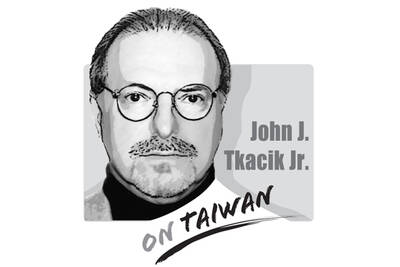Small and medium enterprises make up the backbone of Taiwan’s economy, yet large corporations such as Taiwan Semiconductor Manufacturing Co (TSMC) play a crucial role in shaping its industrial structure, economic development and global standing.
The company reported a record net profit of NT$374.68 billion (US$11.41 billion) for the fourth quarter last year, a 57 percent year-on-year increase, with revenue reaching NT$868.46 billion, a 39 percent increase.
Taiwan’s GDP last year was about NT$24.62 trillion, according to the Directorate-General of Budget, Accounting and Statistics, meaning TSMC’s quarterly revenue alone accounted for about 3.5 percent of Taiwan’s GDP last year, with the company’s full-year revenue expected to represent an even higher share.
However, when considering actual GDP contribution (value-added impact) — excluding imported equipment and materials — the net effect is estimated to be about 5 or 6 percent.
Additionally, TSMC supports about 1,600 Taiwanese suppliers, highlighting its extensive economic footprint. While Taiwan’s N+1 policy aims to retain cutting-edge technology, overseas expansion might lead to talent outflow, impacting Taiwan’s long-term research and development capabilities.
On the economic front, Taiwan’s semiconductor industry output reached NT$4.3 trillion, accounting for 18 percent of GDP and contributing 60 percent of total exports, the Ministry of Economic Affairs has said.
TSMC aims to grow its revenue by more than 20 percent this year, driven primarily by surging artificial intelligence (AI)-related demand, with AI server and processor revenue expected to double, reaching 18 percent of total sales, as reported by the Wall Street Journal.
However, exports in traditional sectors would remain challenged by China’s real estate downturn and ongoing US-China tensions.
Geopolitically, the US$52.7 billion CHIPS Act aims to reduce the US’ reliance on Taiwanese semiconductors, potentially weakening Taiwan’s strategic leverage.
If TSMC expands globally, Taiwan’s “silicon shield” could be diminished, leading to less global attention to Taiwan’s security.
To navigate these challenges, Taiwan must safeguard its technological leadership, strengthen local research and development, and diversify its industries.
From a “silicon shield” to a “global TSMC,” Taiwan’s future would depend on how well it balances global expansion with domestic competitiveness.
Gary Chen is a former associate research fellow in the Department of International Affairs at the Taiwan Institute of Economic Research.

Somehow, US intelligence identified “the Houthis’ top missile guy” and pinpointed his exact location. At 1348 hours (Washington time), March 15, President Trump’s national security advisor Mike Waltz texted, “positive ID of him walking into his girlfriend’s building.” The unsuspecting Romeo entered. High above, the drone monitoring the building registered a flash. When the smoke cleared, Mr. Waltz texted, “…And it’s now collapsed.” RIP. The star-crossed “top missile guy” had been target number one in the now uproarious US Navy bombing campaign on that Sunday against the Yemeni rebels who have been holding the Red Sea hostage since October 19,
China on Tuesday, April Fool’s Day, began two-day joint-force military exercises around Taiwan, painting them as a “severe warning and forceful containment against Taiwan independence.” However, the exercises have again proven the country increasingly showcasing its military muscles to be a true “troublemaker.” Without prior notice, the Chinese People’s Liberation Army’s (PLA) Eastern Theater Command launched large-scale exercises codenamed “Strait Thunder-2025A,” deploying aircraft, drones and naval vessels including the Shandong aircraft carrier, as well as armed militia in the air and waters around Taiwan. The PLA claimed the military exercises were practice for precision strikes and a blockade to “close
Days ago, foreign media reported that Chinese People’s Liberation Army (PLA) Eastern Theater Command Director Lin Xiangyang (林向陽) is suspected to have disappeared under suspicious circumstances. The Eastern Theater Command is the core military department responsible for operations against Taiwan — the purging of its director, if true, would be a major blow to the morale of the Chinese military and the success of its training. On Tuesday morning — April Fool’s Day — the Chinese Communist Party’s (CCP) Eastern Theater Command suddenly announced the launch of joint military exercises in the air and maritime spaces surrounding Taiwan. The exercises
During the four-day Tomb Sweeping Festival holiday, many recall campaigns set up temporary stalls in their electoral districts to encourage more eligible voters to sign second-phase recall petitions. As of Wednesday, a total of 47 recall efforts — targeting 35 Chinese Nationalist Party (KMT) lawmakers and 12 Democratic Progressive Party (DPP) lawmakers — had advanced to the second phase, which requires signatures from at least 10 percent of eligible voters in the constituency within 60 days to proceed to a final vote. Nearly all recall petitions against KMT legislators cleared the first-phase review and launched their second phase between March 8 and